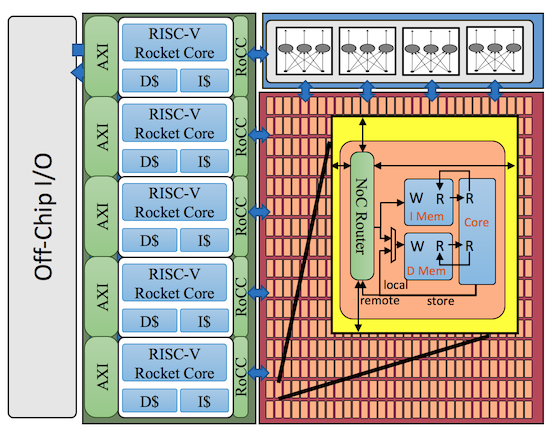BaseJump: Building the DNA For Open Source ASIC Systems
Brought to you by Taylor's Bespoke Silicon Group.
|
|
|
Our vision is to create a path that allows researchers to
prototype their ideas without worrying about all of the
intricacies of I/O, packaging, PC board design and FPGA coding.
Our goal is to shave 10-15 people-years off of a typical ASIC prototype
development process, and at the same time enable artifacts that are
of superior performance to what most research groups would have the resources to do.
We have implemented a complete system that extends from the pad
ring of the chip all the way out. You just need to design your
verilog to connect to our simple interface, and then
make use of the pre-built components that we have developed and tested.
Push it through IC Compiler, PrimeTime and Calibre to a tapeout. The rest
of the way has already been thought out.
Current Users:
University of Washington
University of Utah
University of Toronto
Princeton University
University of Illinois Urbana Champagne
Massachusetts Institute of Technology
University of California, San Diego
U of Cambridge
Cornell
U. Michigan
Prof. Michael Taylor
Bespoke Silicon Group
University of Washington CSE and EE
|
BaseJump Projects
BaseJump STL (Standard Template Library) for SystemVerilog
BaseJump Manycore
BlackParrot RISC-V Linux Capable Multicore
BaseJump ASIC Sockets
BaseJump ASIC Motherboards
BaseJump FPGA Bridge
BaseJump RoCC Doc
RV-IOV: RISC-V IO Virtualization
Most of these components have been combined and used in the
511 RISC-V Core Open Source Celerity chip which was taped out
in TSMC 16nm FinFet technology:

BaseJump STL: A standard library for SystemVerilog
This library has many of the standard components that you use in hardware design.
But these ones are nicely parameterized, and try to use latency-insensitive
interfaces where it does not hurt performance.
We are always looking for those who want to contribute, write testing code,
or offer feedback.
These are good projects for students looking for summer projects.
See the repository here.
BaseJump ASIC Socket
The BaseJump ASIC Socket interface provides a standardized interface for new ASIC accelerators to use, allowing fast time to market and low NRE.
You match up your RTL with our Network-On-Chip interface, and then you can use our package, board, and PHY/MAC layer, provided in portable SystemVerilog for both FPGA and ASIC, to make a complete system!
You can use our RTL, socket interface, our pad ring, our package, and our board all independently of each other. But you will minimize design time and cost if you use them all together!
Our socket interface, pad ring, package and board are all jointly optimized for signal integrity.
See detailed information on:
BaseJump Socket 352
BaseJump Socket 355
BaseJump ASIC MotherBoards
We also provide standardized ASIC motherboards for use in rapidly bootstrapping your systems. These comply with the various BaseJump ASIC socket interfaces.
See these links:
BaseJump Socket 352 Motherboards
BaseJump LVCMOS Link (ASIC-to-ASIC and FPGA-to-FPGA Bridge)
The BaseJump FPGA Bridge is designed to work with BaseJump Socket.
It is synthesizeable SystemVerilog that implements a high-speed DDR source
synchronous communication channel (PHY, link and MAC layer.)
It is designed to be instantiated into an ASIC, and allows high speed
communication through the BaseJump BGA package to another FPGA.
We also support, for Double and Real Trouble, an additional hop that goes from
a "gateway" FPGA over FMC to an ML-605 or Zedboard
which hosts the DRAM memory system and/or and PCI-E host to a PC. The idea is
that if you reuse the BaseJump Socket
Interface, you can attached your RTL verilog to a working I/O system
with very little effort.
See BaseJump STL bsg_link.
Note we have Spartan-6 specific code for the bridge that uses the FPGA SerDes. Send us an email and we will post it.
BaseJump BSG PCI Express Implementation
This module allows an Virtex-6 ML-605 board to communicate with Linux 2.6 via the PCI Express connector.
The abstraction is a number of flow-controlled
FIFOs that are mapped into user space Linux. Your user code reads and writes to the FIFOs
via memory-mapped I/O.
Source code is available here: bitbucket.org/taylor-bsg/bsg_pci
UCSD has a PC<-->FPGA board infrastructure called
RIFFA. It has a wider variety of
supported boards, but focuses on DMA from DRAM. We would guess that the latency
is higher but that the throughput is better.
The BaseJump RV-IOV (RISC-V Virtualization)
Further Steps
Contact information: Contact Prof. Michael B. Taylor for more information.
This work funded by National Science Foundation Grant #1059333
(Collaborative Research: II-NEW: Prototyping Platform to Enable Power-Centric Multicore Research).
Thanks to Prof. Chris Batten of Cornell and Prof. Steven Swanson for feedback and collaboration.
Thanks to Ningxiao Sun for his stellar Double Trouble PCB design, and for Scott Davidson, Shengye Wang, Luis Vega
and Bunnie Huang for all of their engineering assistance on the board!
Terms: You may use this infrastructure at your own risk, and as long as you
agree not to hold us liable for any issues that occur as a result of your use of the infrastructure.
This infrastructure is intended for prototyping uses only and has not been validated for use in any
product.


